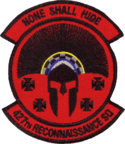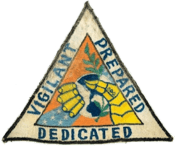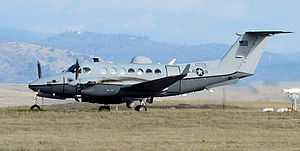427th Reconnaissance Squadron
| 427th Reconnaissance Squadron | |
|---|---|
|
MC-12 Liberty taking off from Beale AFB, 25 January 2013 | |
| Active | 1917–1962; 2012–Present |
| Country | United States |
| Branch | United States Air Force |
| Type | Reconnaissance |
| Part of | Air Combat Command |
| Insignia | |
| 427th Reconnaissance Squadron emblem |
 |
The 427th Reconnaissance Squadron is an active United States Air Force unit. It is assigned to the 9th Operations Group, Air Combat Command, based at Beale AFB, California.
Mission
Re-activated on 1 May 2012, the 427th Reconnaissance Squadron organizes, trains, equips and deploys MC-12W aircraft and aircrew in support of combatant commander-directed operational requirements.[1]
History
Formed at Kelly Field, Texas as the 38th Aero Squadron after the United States' entry into World War I. Not deployed to Europe, remained in the United States, being assigned to Chanute Field, Illinois. Demobilized and inactivated in December 1918.[2]
Reactivated in 1933 as the 38th Pursuit Squadron, at Selfridge Field in 1933; reassigned to March Field, California in 1936, re-designated as a reconnaissance squadron and was equipped with a mixture of B-18 Bolo medium bombers; observation aircraft and Northrup A-17A attack dive bombers, all used for reconnaissance. Performed reconnaissance and photographic missions in support of flood-relief operations in Southern California, 2–5 March 1938.

Ordered to Fifth Air Force in the Philippines in November 1941 to reinforce air defenses of the Commonwealth due to rising tensions between the Japanese Empire and the United States. Air echelon departed on 6 November 1941 en route to Philippine Islands, arrived Hickam Field, THawaii Territory, during Japanese attack on Pearl Harbor on 7 December 1941; ground echelon departed San Francisco aboard ship, 6 December 1941, turned around and returned to March Field on 9 December 1941. In Hawaii, the remains of the air echelon flew patrol and search missions in mid-Pacific under direction of the Hawaiian (later Seventh) Air Force, later departing for Australia where the pilots were organized into other squadrons, the B-18s being used for non-combat duties. Ground personnel reassigned to other squadrons at March; the 38th Reconnaissance Squadron becoming a paper unit.
Assigned administratively to the 19th Bombardment Group at Gowen Field, Idaho in late February 1942. Reequipped and re-manned on 13 March 1942, absorbing the personnel and B-17 Flying Fortresses of the 31st Reconnaissance Squadron, which was inactivated. Received new designation as 427th Bombardment Squadron (Heavy), a unit of the 303d Bombardment Group, and deployed to Southern California flying antisubmarine patrols over the Pacific coast. Completed training in southwest June–August 1942; deploying to European Theater of Operations (ETO) with the 303d BG as one of the initial heavy bomber groups assigned to VIII Bomber Command in England, September 1942.
Engaged in long-ranger strategic bombardment operations over Occupied Europe and Nazi Germany, September 1942 – May 1945. The 427th was one of the most highly decorated squadrons in the Eighth Air Force, attacking enemy military and industrial targets as part of the United States' air offensive against Nazi Germany. After the German Capitulation in May, 1945 was reassigned to Air Transport Command. Reassigned to Casablanca, French Morocco, the squadron used its B-17 bombers as transports, ferrying military personnel from locations in France to Morocco, then south to Dakar in French West Africa or to the Azores for further transportation by other units. Inactivated in place in Morocco in late July 1945.
The squadron was activated in 1959 as a result of Strategic Air Command phasing out the B-47 Stratojet, and additional squadrons were activated as part of the consolation of Stratojet wings, and the replacement of the B-47 by B-52 Stratofortresses. In March 1961, President John F. Kennedy directed that the phaseout of the B-47 be accelerated. and the squadron was inactivated on 1 January 1962 as part of the drawdown of the USAF B-47 force, with the aircraft were sent to AMARC storage at Davis-Monthan.
Lineage


_-_Emblem.png)
38th Aero Squadron
- Organized as the 38th Aero Squadron on 12 June 1917
- Redesignated Squadron A, Chanute Field, Illinois, on 13 July 1918
- Demobilized on 1 December 1918
- Reconstituted c. 1 August 1933 with the 38th Pursuit Squadron as the 38th Pursuit Squadron[4]
427th Reconnaissance Squadron
- Constituted as the 38th Pursuit Squadron on 24 March 1923
- Consolidated with Squadron A, Chanute Field, Illinois c. 1 August 1933
- Activated on 1 August 1933
- Redesignated 38th Observation Squadron (Long Range, Light Bombardment) and inactivated on 1 March 1935
- Redesignated 38th Reconnaissance Squadron and activated on 1 September 1936
- Redesignated 38th Reconnaissance Squadron (Long Range) on 6 December 1939
- Redesignated 38th Reconnaissance Squadron (Heavy) on 20 November 1940
- Redesignated 427th Bombardment Squadron (Heavy) on 22 April 1942
- Redesignated 427th Bombardment Squadron, in 1944
- Inactivated on 25 July 1945
- Redesignated 427th Bombardment Squadron, Medium on 20 August 1958
- Activated on 1 December 1958
- Discontinued and inactivated on 1 January 1962[4]
- Redesignated 427th Reconnaissance Squadron on 17 August 2011
- Activated on 1 May 2012
Assignments
- Post Headquarters, Kelly Field, 12 June 1917
- Post Headquarters, Chanute Field, 25 August 1917 – 1 December 1918
- 18th Pursuit Group
- Attached to 1st Pursuit Group, 1 August 1933 – 1 March 1935
- 1st Wing (later 1st Bombardment) Wing
- Attached to 19th Bombardment Group, 1 September 1936
- Attached to 19th Bombardment Group, 19 September 1941
- Sierra Bombardment Group, 16 December 1941
- Fourth Air Force, 17 January 1942
- Attached to IV Bomber Command, 26 January 1942 (Unmanned and unequipped)
- 19th Bombardment Group, 25 February 1942
- Attached to 303d Bombardment Group for training, 13 March 1942
- 303d Bombardment Group, 31 March 1942 – 25 July 1945
- 303d Bombardment Wing, 1 December 1958 – 1 January 1962.
- 9th Operations Group, 1 May 2012 – present
Stations
|
|
Aircraft
|
|
See also
References
Notes
- ↑ 427th Reconnaissance Squadron factsheet
- ↑ Maurer, Combat Squadrons, pp. 523-525
- ↑ This plane, s/n 40-2070 was caught on approach to Hickam on 7 December 1941 by strafing Japanese Fighters, who left it burned out on the ramp. The bomber's flare storage box had been struck by rounds fired by the Japanese fighters as the Fortress approached Hickam. The pilot managed to land the burning B-17, which broke in half upon hitting the runway and came to rest just short of the Hale Makai barracks. All of the crewmen but one survived the landing.
- ↑ 4.0 4.1 Lineage, including assignments, stations and aircraft prior to 1963 in Maurer, Combat Squadrons, pp. 523-525
Bibliography
![]() This article incorporates public domain material from websites or documents of the Air Force Historical Research Agency.
This article incorporates public domain material from websites or documents of the Air Force Historical Research Agency.
- Maurer, Maurer, ed. (1982) [1969]. Combat Squadrons of the Air Force, World War II (reprint ed.). Washington, DC: Office of Air Force History. ISBN 0-405-12194-6. LCCN 70605402. OCLC 72556.
External links
| ||||||||||||||||||||||||||||||||||||||||||||||||||||||||||||||||||
| ||||||||||||||||||||||||||||||||||||||||||||||||||||||||||||||||||||||||||


.svg.png)